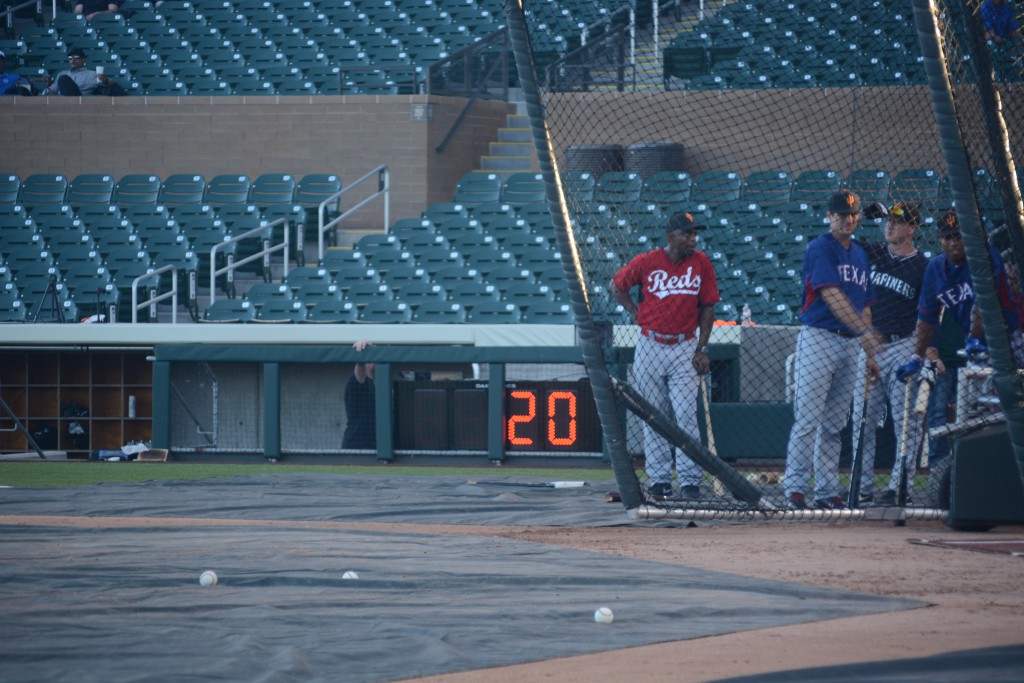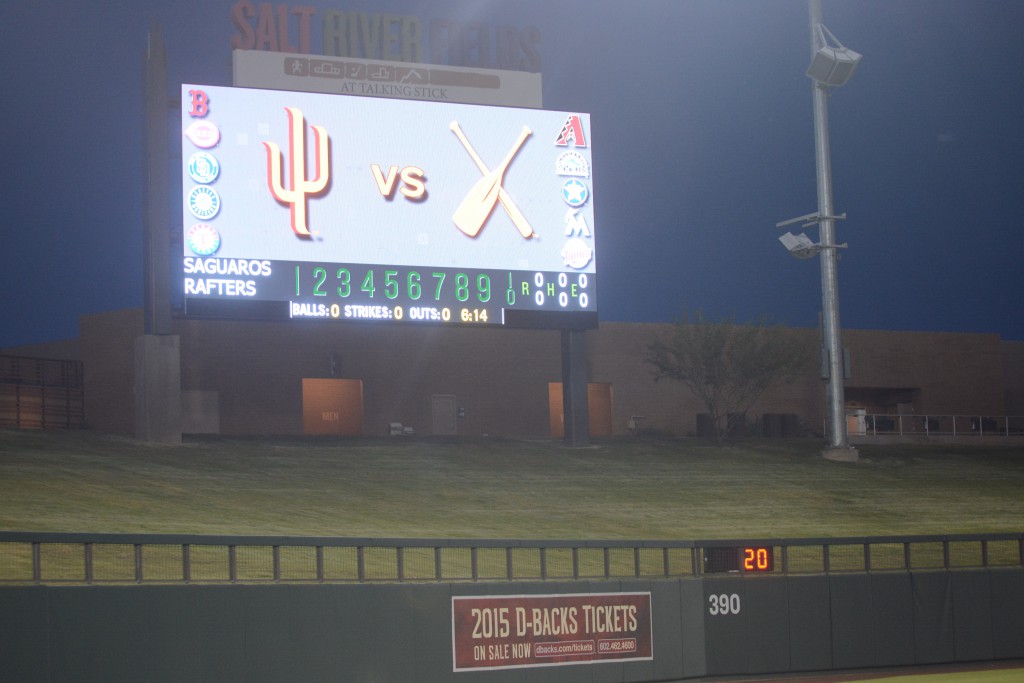Arizona Fall League Implements Tech to Speed Up Pace of Play
At Salt River Fields at Talking Stick, the Arizona Fall League’s Salt River Rafters play their home games with NBA-style shot clocks installed on the field: one in the outfield, two on the backstop, and one in each dugout. All of this is part of MLB’s pace of game initiative intended to shorten the total time of a game.
The rules are simple enough. According to the AFL media guide, pitchers have 20 seconds to throw a pitch. If a pitcher holds the ball for more than 20 seconds without throwing it, a ball will be called. A batter must stay in the box during those 20 seconds, prepared for the pitch; if the batter steps out of the box during that period without calling time, the pitcher may throw the ball and an umpire can call it a strike. The 20 second rule begins once the pitcher is in possession of the ball.
In addition to the 20 second rule, there is a maximum inning break of two minutes and five seconds. The batter must enter the box by the 1:45 mark, otherwise, umpires will call an automatic strike. If the pitcher doesn’t throw the ball by the time the 2:05 is up, the umpire will call an automatic ball.
For pitching changes, there is a 2:30 clock that starts once the new pitcher steps onto the warning track or crosses the foul line. An automatic ball may be called if the new pitcher does not throw before the 2:30 is up.
There is also a maximum of three time outs allowed in a game, called by either player, coach, or manager (such as a visit to the mound). This excludes coaching visits due to an injury or an emergency.
Tyler Heineman, a catcher in the Houston Astros organization, said that players still have to get used to the rules being enforced. As of publish date, there have only been two games played with the clocks in use.
“I thought the pace of game was alright,” Heineman said. “A couple times, we got messed up with a couple of ball ones starting off the inning. Other than that, it was fine.”
Arizona Diamondbacks outfield prospect Evan Marzilli said that the rules change everything.
“It’s not something you’re used to,” Marzilli said. “I mean, I guess if we’re gonna have to implement them, we’re gonna have to go through them.”
Both Heineman and Salt River manager Andy Haines noted that the clocks may force pitchers to rush their routine a bit to get warmup pitches in before the 2:30 concludes.
“It might take away from their first couple of pitches because they’re out of gas,” Heineman said.
Haines added, “I know you see guys kinda jog or walk from the pen. That’s definitely different. There is no jogging or walking or else you won’t be able to throw any warmups. It’s definitely a sense of urgency to get out there.”
A lot of the changes being made are more of a mental challenge for players than anything. Heineman said that he thinks pitchers are trying to zone it out as much as possible.
“In the beginning of the innings, it might speed up their routine a little bit, but in between pitches, the 20 seconds really has no effect on them,” Heineman said.
Marzilli agreed that the 20 second rule doesn’t affect him.
“The between pitches [clock] doesn’t really bother me too much,” Marzilli said. “But definitely being in the outfield, coming in, having to run, and kinda rush, it’s something you’re not used to.”
Pitchers throwing within the 2:05 and 2:30 periods is something that they noted they needed to work on, with the Rafters’ starting pitcher Mark Appel being caught going past the time mark and starting off the count at 1-0.
“We saw [the differences] tonight, with a bunch of balls being called that guys weren’t even throwing them,” Marzilli said. “It is different, but we’ll see how it works out.”
Prior to the beginning of the AFL season, Haines said that the Salt River club ran simulated games where they would time the pitchers from the bullpen.
“Just to give them a heads up of where they were, that you were on schedule, you’re a little slow,” Haines said, “so they weren’t totally thrown off guard when they got out here, so they got a little bit of a heads up.”
Testing the initiative in the Fall League is something that makes the most sense, according to Haines.
“I don’t think any of us want them to try to experiment at the major league stadium,” Haines said. “They need to experiment; this is certainly the place to do it. I don’t think that’s even debatable.”
Haines respects Major League Baseball for the initiative itself, calling it something that they’re doing that is best for the game, even if it is a short period of time to test it in the Fall League. Haines also does not think that it will affect players negatively — in fact, it would only help them in the long run.
“If they do want to implement this, these players here will have an advantage because they’ll be conditioned a little bit,” Haines said. “I think that’s the way to look at it. I don’t see it being a disadvantage besides the fact that they’re just gonna have to run out there instead of walk or whatever their routine is, and just be aware of it. It’s a short window. They’re not asking us to do this for six months. It’s a six-week season. And it’s limited exposure for the players as far as this goes. And we’re getting good feedback. If they make a mistake, it’s ball one, it’s not the end of the world. We’ll learn from it.”
All photos by Jen Mac Ramos.
Jen is a freelance writer. Read all of their writing on their website, and follow them on Twitter @jenmacramos.


I truly hope that this experiment is a failure. It’s a sop to the know-nothings, the dim-witted talkshow hosts and casual fans. Baseball is the greatest game because it is what it is. Call me a Luddite, but clocks and baseball are a non-sequitur.
The entire point of this exercise is to allow the broadcasts to add yet more ads and keep the time the same as it is now so that a higher proportion of what we watch will be ads rather than the game. They’re trying to sell it as a fan-friendly measure, but it’s merely an attempt to increase revenue through advertising.
If that were the case, why would they limit the time between innings to 2:05? Shouldn’t that be the longest break allowed to grant as much advertising space possible?
Because it’s the Arizona Fall League. Should the “shot clock” be implemented in games that can actually sell ad time, I assure you the break between innings will be longer.
Interesting about the foul line rule for places like SF. I wonder though, is there an additional rule attached that states that the pitcher must approach the mound by the most direct route? If not, I wonder if pitchers might try to exploit this by not crossing the foul line until they are even with the mound to buy manager a few more moments to think about the next part of his game plan.